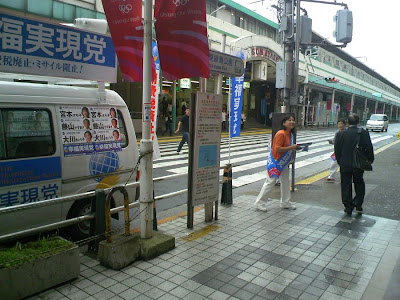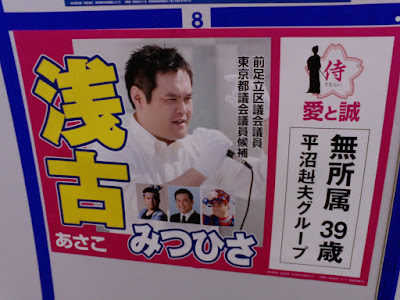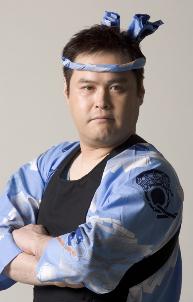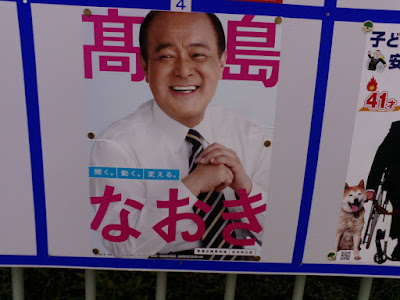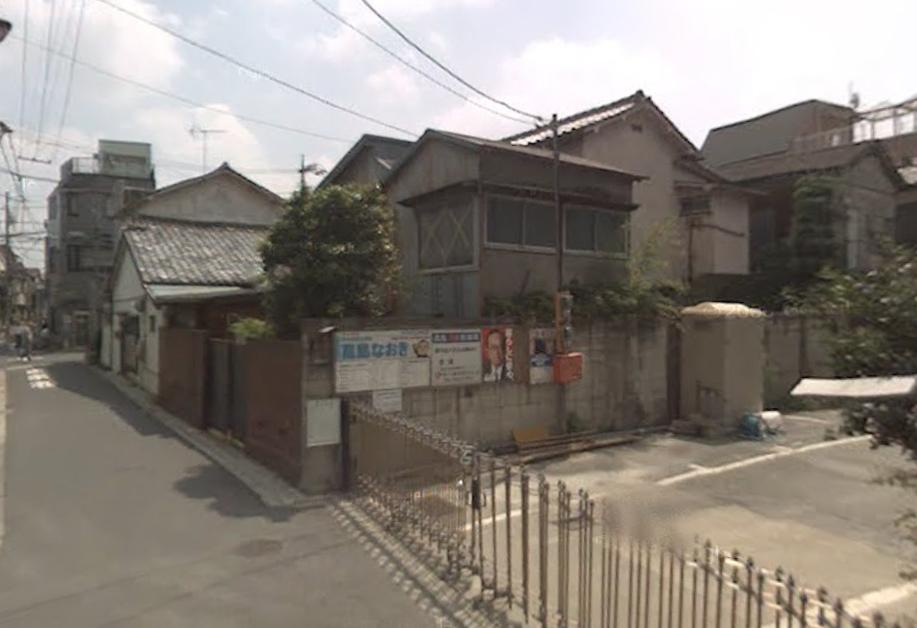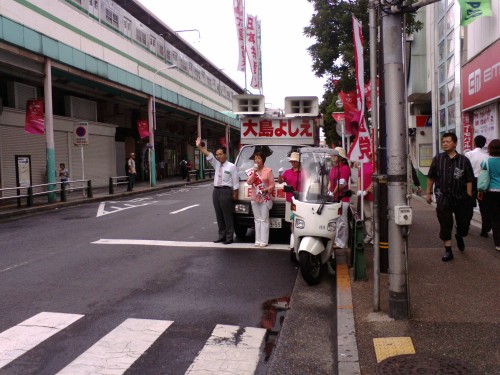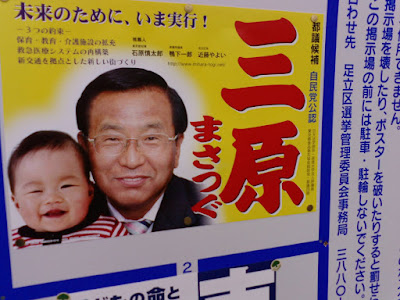I am wrapping up this profile series on the final night of campaigning. All ten candidates have had their vans drive by my apartment at least once. Since the average time someone can listen to a passing van is about 3 seconds, the candidates’ strategy seems to be “forget about policy, just repeat your name again and again.”
Last but not least is Sachiko Miyamoto, the candidate sponsored by the infamous Happiness Realization Party:
 |
| From Tokyo Prefectural Assembly Election |
The Happiness Realization Party was formed in May of this year as the political wing of Buddhism-based new religion Happy Science, which claims to have somewhere around 10 million followers (compared to between 12-20 million for Soka Gakkai), an enormous rate of growth for a faith that only started in 1986. I am not sure exactly why Happy Science decided now is the time to enter politics, but they seem to be very well-funded and serious about trying to get elected (their resources quite obviously outstrip someone like Osato Ichikawa).I have probably gotten more literature from HRP than anyone else during this election cycle. Also, they make no attempt to hide their affiliation with Happy Science – it says so right there on the literature.
Whatever else the HRP might have wrong with it (and there’s a lot), you cannot accuse them of thinking small. Every proposal they have is radical and sweeping. This video from their official Youtube channel makes it look like they are prepared to conquer the earth just to install a high-speed rail network:
As you can see from the video, the HRP is promising to build nothing less than a utopia in Japan – prosperous, safe, and above all happy. Unfortunately they are light on details on how they could bring this about.
Among their chief policy proposals:
- Revise the constitution to allow a pre-emptive strike on North Korea if necessary.
- Eliminate inheritance taxes and consumption taxes.
- In the cities, “bring work and home closer together” by building offices and residences in the same building.
- Build an enormous monorail around the entire city of Tokyo.
- Allow massive immigration and promote reproduction to increase Japan’s population to 300 million by 2050
Some of their most radical proposals can be found in their draft constitution:
- Make a directly elected president the head of state. The president would have the right to issue presidential orders apart from parliamentary legislation. If an order and legislation contradict each other, the chief justice of the supreme court would decide which to follow. But if there is no decision in two weeks, the presidential order will take precedence.
- The emperor “and other traditions” would be kept on but with their power limited by law.
- The chief justice of the supreme court would be directly elected.
- Payment for public bureaucrats would be based on performance (this would be in their constitution!)
- “Equal opportunity” and total freedom within the law.
- The state must always aim to have a small government with low taxes.
- “The mass media must not abuse their power and must act responsibly to the people.”
I am not sure how exactly this is related to the Happy Science teachings, and frankly I don’t care. Their mythology is complicated to the point that it’s just about impenetrable. All anyone needs to remember is that Happy Science is that it is a personality cult above all else. They believe that the founder Ryuho Okawa had a vision in the 80s that he is essentially the savior of mankind. If you’re interested in learning more I am sure they’d be happy to talk to you.
Career: Miyamoto’s website offers precious little information. She apparently moved around a lot as a kid – born in Itabashi-ku, then moved to Wako-shi in Saitama through middle school followed by Koshigaya for high school. After studying French in college, she worked for the Palace Hotel company for two years until she got married in 1981. From then until deciding to run for office, she has apparently held no job or responsibility besides raising her two boys to adulthood.
Policy: The main point of her candidacy is to spread the message of the national HRP. To do that, in her speeches she constantly repeats that the HRP is “the party of zero consumption taxes.”
In her more detailed campaign literature, she says Tokyo needs a “transportation revolution” with the following main policies: build another highway on top of the most crowded sections of the Shuto Expressway; make intersections and rail crossings “three-dimensional”; and install double-decker train cars for use at rush hour.
Something interesting: Miyamoto is a mysterious blank slate, so I don’t know what to say here.
 |
| From Tokyo Prefectural Assembly Election |
***
And so ends my attempt to humanize these people! Once the election is over I will be back with some reflections on voting and analysis of the results. Just for the record, here is my projection of the winners, in descending order of votes:
- Satoru Onishi (DPJ)
- Haruhisa Tomotoshi (New Komeito)
- Nobuyuki Nakayama (New Komeito)
- Yoshie Oshima (JCP)
- Naoki Takashima (LDP)
- Katsuhiro Suzuki (DPJ)
That’s right, I am predicting the LDP will walk away with just one seat. One anonymous Adachi-ku assembly member put the chances of this happening at “around 70-80%” and I am inclined to agree.

